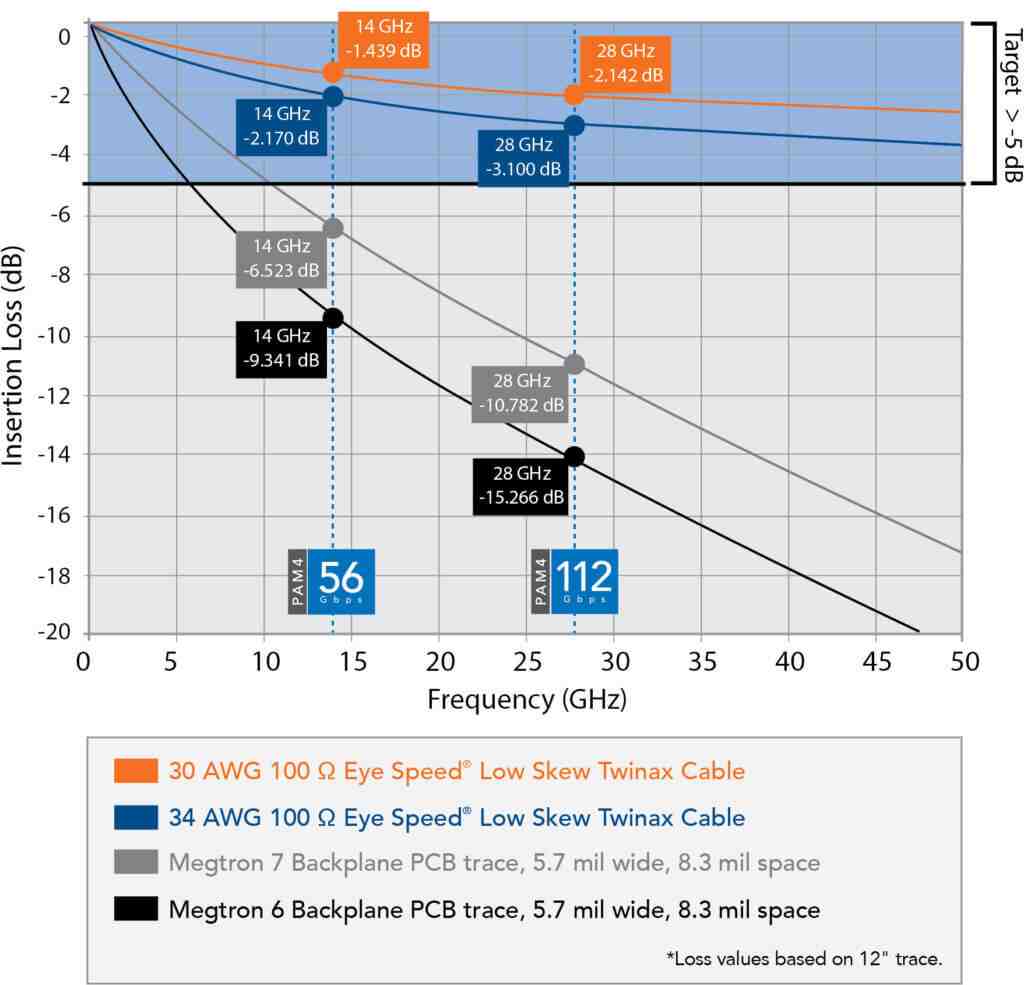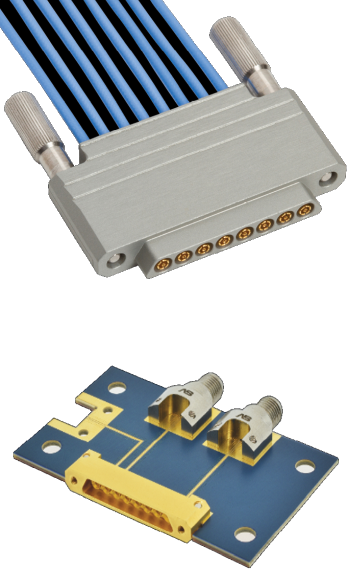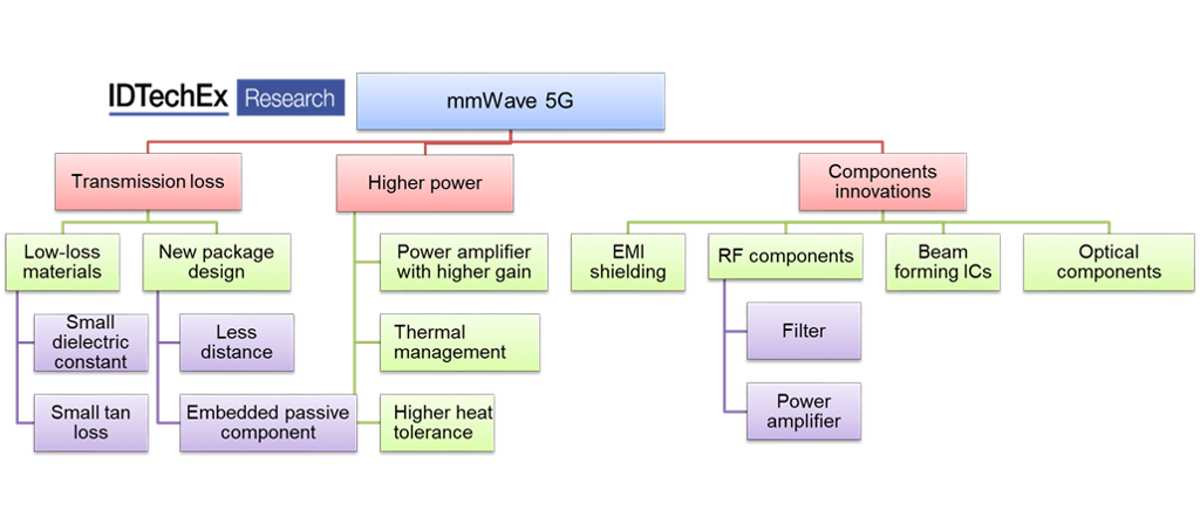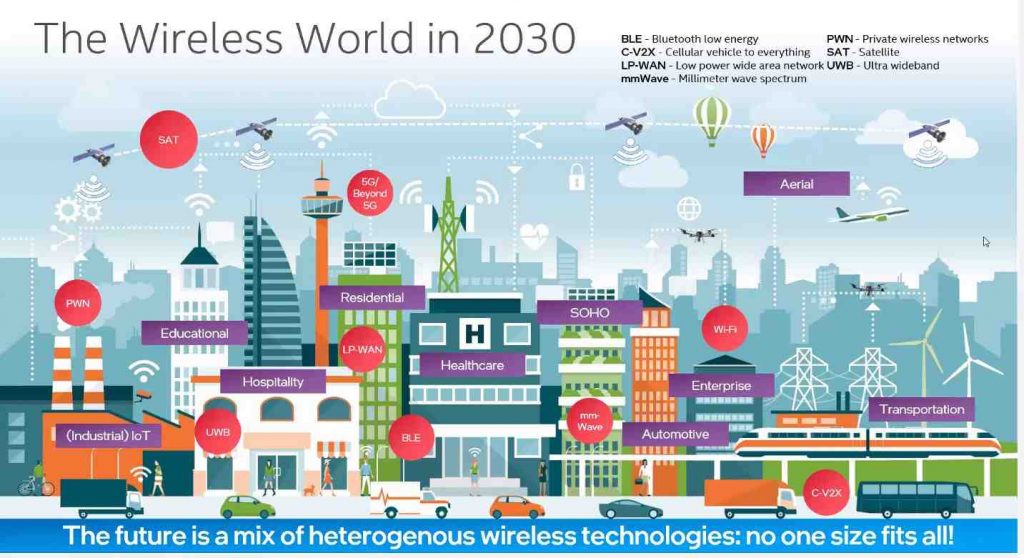Connectors are an important component in radio frequency (RF) systems, especially in high frequency applications such as 5G Gigahertz (GHz) devices. Designers have a wide variety of connectors to choose from, but there are a few key parameters to consider when narrowing down the choice. The six keys to selecting and integrating a GHz connector include physical size, frequency range capability, power handling, voltage standing wave ratio (VSWR) and return loss, passive intermodulation distortion (PIM), and unwanted electromagnetic interference (EMI) control. The physical size of the connector, frequency range, and power handling capability are interrelated (Figure 1).
Some of the common connector types used in RF applications include:
BNC connectors are inexpensive, include a locking mechanism to prevent accidental disconnection, and are available with a characteristic impedance of 50 or 75 . BNC connectors are typically rated for 500V and average power around 100W to around 1 GHz; however, they are most commonly used at 500 MHz and below.
The TNC connector is a threaded version of the BNC connector. Threads provide a more solid connection that can withstand vibrations and handle higher frequencies and power levels than BNC.
The N connector is sturdy and inexpensive. The standard version is rated at 11 GHz, with a precision design capable of operating up to 18 GHz. Like BNC connectors, N connectors are available with a characteristic impedance of 50 or 75 .
SMA, sub-miniature type A, connector rated up to 18 GHz, with design precision up to 26.5 GHz. They can handle power levels between BNC and TNC connectors.
The 3.5 mm connector is a precision design similar to the SMA connector but with an air dielectric that supports frequencies up to 34 GHz. 3.5mm connectors tend to have a lower power rating compared to SMA connectors.
The 2.4mm connector is rated up to 50 GHz and is available in three grades; general purpose, instrumentation, and metrology. They have limited power handling capabilities.
The 2.92mm/K type connector performs similarly to the 2.4mm design, but is limited to 40 GHz. They can be used on all K-band frequencies.
The Type-C connector uses a bayonet retainer which is similar to the BNC but is designed to handle much higher power levels. Standard Type C connectors are rated for 50 , but 75 designs are also available. There are versions with threaded collars for a more secure connection, such as the TNC connector.
The 7-16 DIN connector has largely replaced the Type-C connector, and can handle somewhat higher power levels. This connector has an inner conductor with a diameter of 7 mm and an outer conductor with a diameter of 16 mm. They use an M29 x 1.5 threaded coupling nut.
EIA series coaxial connectors are available in a variety of sizes, including EIA 7/8”, EIA 1 5/8”, EIA 3 1/8”, EIA 4 1/2”, and EIA 6 1/8”. This high power connector can be used with foam or air dielectric cables.
Return loss and VSWR are important metrics of RF interconnect system performance. The main difference between return loss and VSWR is that return loss is a logarithmic measurement, so it is useful when measuring very small reflections. In contrast, VSWR is a linear measurement and helps to measure larger reflections.
In general, a return loss of 15 dB or better is considered an acceptable overall return loss for cable and antenna systems. Higher return losses are preferred. A 20 dB return loss system is very efficient because only 1% of the power is returned, and 99% is transmitted, whereas with a 10 dB return loss, 10% of the power is returned, and only 90% is transmitted.
VSWR measures the amount of signal reflected by the connector; it is the ratio of the applied voltage to the reflected voltage and is a major factor in the efficiency of the connector signal. VSWR displays the system match in a linear manner. The perfect or ideal match in VSWR terms is 1:1. Typical VSWR for RF connectors is around 1.43 (15 dB), but can range up to 2.0. VSWR relates to frequency, and for certain connectors, is usually higher at higher frequencies.
Connector geometry and material play a major role in determining VSWR. Inline connectors typically have a higher VSWR than right-angle connectors, especially at frequencies close to the connector limit. This is due to the two-part internal straight contact configuration which allows easy and low cost assembly with internal impedance control. The recently released high frequency right angle SMA adapter replaces the straight contact configuration with an internal swept right angle configuration with a two-part concept. It combines all the low profile, compact size, and other physical advantages of standard right angle connectors while maintaining electrical performance comparable to conventional straight connectors. In addition to the improved internal geometry, the high-performance right-angle SMA adapter has a gold-plated brass body and gold-plated beryllium copper contacts.
Connector integration considerations
Through-hole connectors exhibit some insertion loss as the pins act like inductive/capacitive impedance discontinuities. Impedance mismatch caused by surface mount bearings in connectors is a major source of return loss. Once the signal reaches the wider copper surface mount connector pad, the capacitance per trace length is greater, reducing the characteristic trace impedance of the connector pad. This capacitive impedance discontinuity causes signal reflection, which results in re-loss of the connector.
Adding a second small layer of ground under the connector can help eliminate problems with capacitive impedance discontinuities. (Figure 2). A cut in the ground plane of the same size as the connector pad and below the signal layer forces the trace to refer to the ground plane in the third layer. That results in higher capacitance and helps reduce capacitive impedance discontinuities, which reduces connector return losses.
Passive intermodulation (PIM) occurs when two signals present on a transmission line mix in a non-linear manner. This mixing creates additional frequency components that may be included in the uplink band, causing interference. There are three common sources of PIM:
PIM design can be caused by passive components such as connectors. There is often a trade-off between lower cost, smaller size or lower system performance, and higher PIM rates when specifying connectors.
PIM assembly/aging results from improper installation or long-term weathering of connectors and other passive components. Higher quality and more expensive connectors can help address this PIM source.
Environmental PIM, also called ‘rusty bolt’ PIM, results from external environmental factors. Corrosion of antennas or structural elements is a common source of environmental PIM. Connectors rarely contribute to this source of intermodulation interference.
5G user equipment (UE) devices such as handsets challenge the EMI source pool with multiple RF subsystems, including GPS, Wi-Fi, Bluetooth, and various cellular connections, including mmWave 5G. For example, the 5G mmWave subsystem in the handset is located near the CPU core and other sensitive devices which raises electromagnetic compatibility (EMC) issues. One potential solution is to use microstrip and stripline mini coaxial connectors combined with cable grounding and wiring management to provide a series of successively more effective EMI/EMC solutions.
A simple and low-cost approach is to implement a board-to-wire solution using microstrip interconnects (Figure 3). This approach provides a micro-coaxial connection to the microstrip structure on the circuit board. It uses only two layers of metal on the PCB, saving costs, but may not suppress enough EMI radiated at higher frequencies to comply with EMI/EMC regulations.
When the basic micro-coaxial connection to the microstrip does not meet the required performance level, the addition of an SMT earth clip can help reduce EMI further by suppressing the EMI-induced current in the cable shield. It can also help improve cable routing management on PCBs. The ground clip localizes the EMI radiation to the area around the connection point, reducing it along the microstrip line.
For applications requiring higher performance, a 3-ply strip transmission line structure can be used (Figure 4). The use of special cap connectors can further improve performance. The ground layer completely contains signal conductors, providing a high level of protection.
For highly sensitive applications requiring the highest EMI shielding suppression, the addition of an SMT earth clip improves the performance of the RF shielded strip-to-micro-coaxial connector structure.
As discussed above, four consecutive improvements in EMI shielding effectiveness in EU 5G devices can be achieved using:
The RF connector is a critical component of meeting link budgets and overall performance demands across a wide range of 5G systems from base stations to EU devices. Designers have a wide choice of RF connectors that provide trade-offs in terms of physical size, frequency range capability, power handling, standing wave voltage ratio (VSWR) and return loss, and cost. In addition, successful integration of the RF connector needs to take PIM into account, and control unwanted EMI.
Design Considerations, Tips & Engineering for 5G Connector Solution, i-PEX
Guide to RF Coaxial Cables and Connectors, AR RF/Microwave Instrumentation
High Performance SMA Adapter Improves VSWR Performance Amphenol RF
How will 5G affect business?
Contents
RF Connector for 5G, Pasternack
What Determines Connector Return Loss and Insertion Loss?, Rhythm Design System
- What Is The Difference Between Loss Of Return And VSWR?, Amphenol RF
- Filed Under: Connector TipsTagged With: FAQ
- The growth of 5G networks does not mean 4G will disappear. Cellular carriers will use existing 4G LTE networks to provide their customers’ cellular services well into the next decade. The 5G network will work with 4G — not directly replacing it. As a result, 5G-enabled phones will continue to use 4G technology.
- Business impact The most tangible and immediate benefit of 5G is the increased end-user speed that the network can deliver. Lightning speeds of over 1Gbps accommodate and enhance everyday work habits such as remote work, file sharing and communication capabilities.
How will 5G affect me?
What are the disadvantages of 5G? Deficiency
What is the downside of 5G?
Gigabit cellular communications have so far provided little added value to consumers.
Will 5G affect my phone?
Lack of availability (especially in rural areas)
What is 5G and its advantages?
New device required.
What is 5G network advantages and disadvantages?
More transmission antennas are required for uniform network coverage compared to 4G.
How is 5G different from 4G?
Q: How will 5G affect me? A: 5G is designed to do things that can change our lives, including giving us faster download speeds, lower latency, and more capacity and connectivity for billions of devices—especially in virtual reality (VR), IoT, and intelligence. artificial (AI).
The main disadvantage of 5G is that its global coverage is limited and only available in certain locations. Only cities can get much benefit from 5G networks and remote areas may not get coverage for several years. In addition, the costs for setting up tower stations are high when compared to other networks.
How is 5G technology different from 4G?
The new, faster 5G network means older phones that only connected on the provider’s 3G network will no longer work. Well, that’s not entirely true. The phone will work but won’t work as a phone, at least when you’re away from your home WiFi network.
How is 4G different from 5G?
The main advantages of 5G are greater speed in transmission, lower latency and therefore greater remote execution capacity, more connected devices and the possibility of implementing virtual networks (network slicing), providing connectivity that is more tailored to the needs concrete .
Is 5G any better than 4G?
On the other hand, 5G network allows users to avoid it due to better speed and more bandwidth. The main disadvantage of 5G is that its global coverage is limited and only available in certain locations. Only cities can get much benefit from 5G networks and remote areas may not get coverage for several years.
Which is better 4G or 5G?
The main difference between 4G and 5G is speed – 5G is expected to be much faster than 4G while offering lower latency and better bandwidth. The cellular infrastructure that enables wireless communication is upgraded approximately every 10 years. Currently, 5G is slowly replacing 4G worldwide.
Is 5G better than 4G Why?
Is there a big difference between 4G and 5G? The three main differences between 4G and 5G are faster speeds, higher bandwidth, and lower “latency,” or the time lag in communication between devices and servers.
Does 5G harm wildlife?

With 5G reaching 10 gigabits per second – up to 100 times faster than 4G – 5G networks can deliver the level of performance needed for an increasingly connected society. Results? Downloading a high-definition movie over a 4G network, for example, takes an average of 50 minutes – on 5G, it takes just nine minutes.
The biggest difference between 4G and 5G is latency. 5G promises low latency under 1ms, while 4G latency ranges from 60ms to 98ms. Additionally, with lower latency, there have been advances in other areas, such as faster download speeds. Download speed potential.
Does 5G affect bees?
Overall, due to the new technologies, spectrum and frequencies it employs, 5G has several advantages over 4G; higher speed, less latency, capacity for more connected devices, less interference, and better efficiency.
Are bees affected by radiation?
5G Has Higher Network Capacity Than 4G Network Since 5G has a higher network capacity compared to 4G, 5G network can support up to 100x more traffic. This means more devices and people can connect using a 5G network when compared to a 4G network.
Are bees affected by WIFI?
In theory, 5G will likely reach speeds that are 20 times faster than 4G LTE1. 4G LTE has a top speed of 1GB per second; 5G can theoretically reach speeds of 20GB per second. This is of course what you might call ‘peak speed’, we’ll just have to see when 5G rolls out what real world performance looks like.
Is 5G safe for environment?
The higher frequencies used in 5G technology are known to severely damage insect and bird populations. A 2018 study showed how shorter wavelengths in higher frequencies are absorbed more easily by the insect’s body, creating a warming effect.
How 5G is affecting the world?
How will 5G affect the world? As 5G continues to evolve, people will feel the impact of the 5G revolution. Designed to have faster speeds, greater capacity and lower latency, 5G is expected to be the key to innovation in the future. In particular, increased speed can open up new opportunities in public and business safety.
How will 5G affect the nature?
It has been proven that alternating electromagnetic fields can have harmful effects on bees. Exposure standards are considered, an analysis of the effect of 5G electromagnetic radiation (EMR) on bees and methods of protection against exposure are carried out.
Does 5G affect wildlife?
Kumar (2010), conducted a significant study of honeybees during radiation exposure and revealed the outstanding results of their work 11. The results showed that the life cycle of honeybees is affected by exposure to electromagnetic radiation.
How does 5G affect trees?
Electromagnetic fields from power lines, cell phones, cell towers, and wireless have been shown to negatively impact birds, bees, wildlife and our environment in a variety of peer-reviewed research studies.
What are the effects of 5G on the environment?
Wireless companies, and even government websites such as the CDC and EPA, have been working to reassure the general public that radiation emitted from 5G networks is absolutely safe.
Is the 5G worth it?

“While 4G belongs to the smartphone technology generation, 5G will belong to that generation and the generation of smart factories, smart buildings, smart cities and so on. This will contribute to the creation of businesses and jobs in various sectors and increase the efficiency of existing industries.
5G technology with IoT will be able to increase energy efficiency, reduce greenhouse gas emissions and enable more use of renewable energy. This can help reduce air and water pollution, minimize water and food waste, and protect wildlife.
Is 5G access free?
5G mmW can have a greater impact on organisms with a high surface area to volume ratio: insects, small birds, mammals and amphibians, can be severely affected.
Do you need unlimited data for 5G?
Now they do: Overall, trees cause an average propagation loss of about 35.3 decibels. If placed in a dense forest, it could mean the 5G signal is 1000x less strong.
How do you get access to 5G?
A surge in buying new 5G phones could lead to more greenhouse gas emissions. In addition, making more IoT devices, phones, and small cells will result in more mining and use of a lot of non-renewable metals that are difficult to recycle.
What is 5G innovation?

If customers want faster download speeds, upgrading to 5G may be worth the cost, according to Ookla. The company’s study found that 5G Android devices are twice as fast as the most popular 4G devices in terms of average download speeds in the US.
Can I test 5G? SpeedTest Master is a relatively basic app for Android, which lets you test internet speed and network performance for 4G, 5G, and Wi-Fi cellular connections.
Is 5G a technological innovation?
5G doesn’t technically cost extra, but only in the more expensive unlimited plans.
Is 5G a technology?
To appreciate 5G, you’ll need to upgrade to an unlimited data plan (if you don’t already have one) or pay more for an existing plan depending on your carrier. One way or another, you’ll be paying more for 5G.
What type of innovation is 5G?
Go to Settings > Cellular > Cellular Data Options. If you see this screen, your device has 5G enabled. If you don’t see this screen, contact your carrier to confirm that your plan supports 5G. Turn on Airplane Mode, then turn it off.
Who invented 5G?
The speed of the 4G network alone is not enough, so there is 5G, a technology that will turn smart devices into ultra-smart devices. 5G is the fifth generation technology and standard for wireless communication; i.e. the network used by mobile devices to connect to the Internet anywhere.
What is 5G technology in simple terms? In its simplest definition, 5G is the fifth generation of cellular networks. It’s the next step in cellular technology, what future phones and tablets will use for data, and it should make our current LTE network feel as slow and irrelevant as 3G data looks now.
Who owns the 5G technology?
As 5G is one of the future backbone technologies for autonomous driving, the first 5G network is also being rolled out on a dedicated test site. In addition, 5G-enabled drones and robots can further increase industrial productivity.
What company owns the 5G master key patents?
In telecommunications, 5G is the fifth-generation technology standard for mobile broadband networks, which mobile phone companies worldwide began implementing in 2019, and is the planned successor to the 4G networks that provide connectivity to most of today’s mobile phones.
What company is behind the 5G technology?
While 4G has been considered an incremental innovation over its predecessors (3G and 2G), key design and technology features have shown 5G to be a disruptive innovation. As a result, 5G will create new market value, where new services and applications will emerge in unexpected ways.


